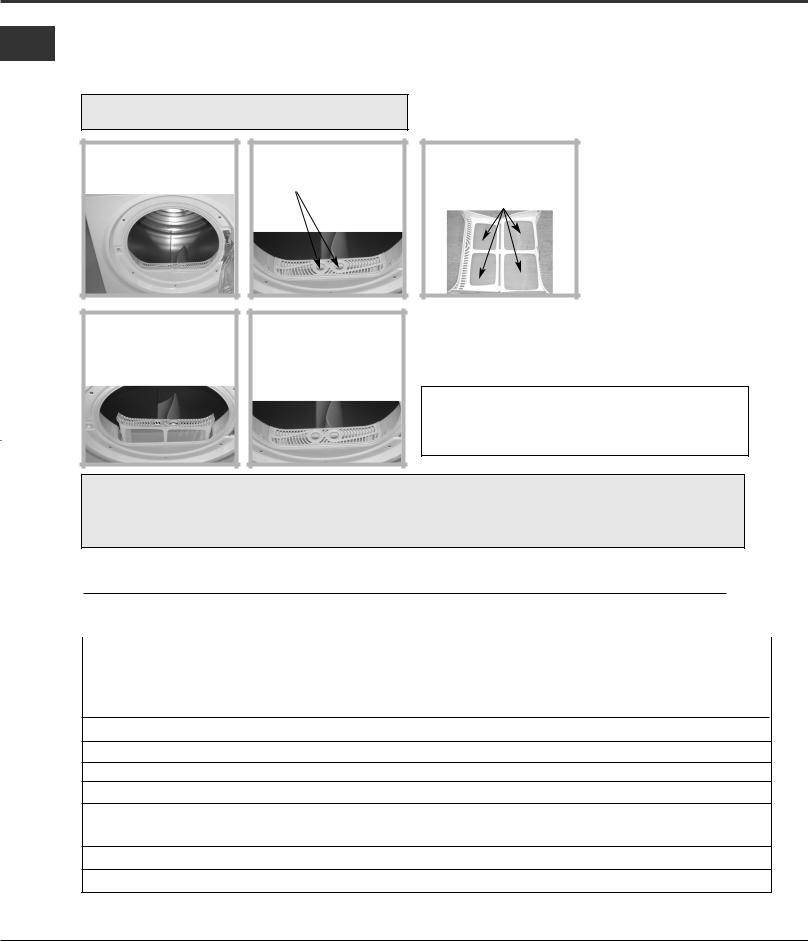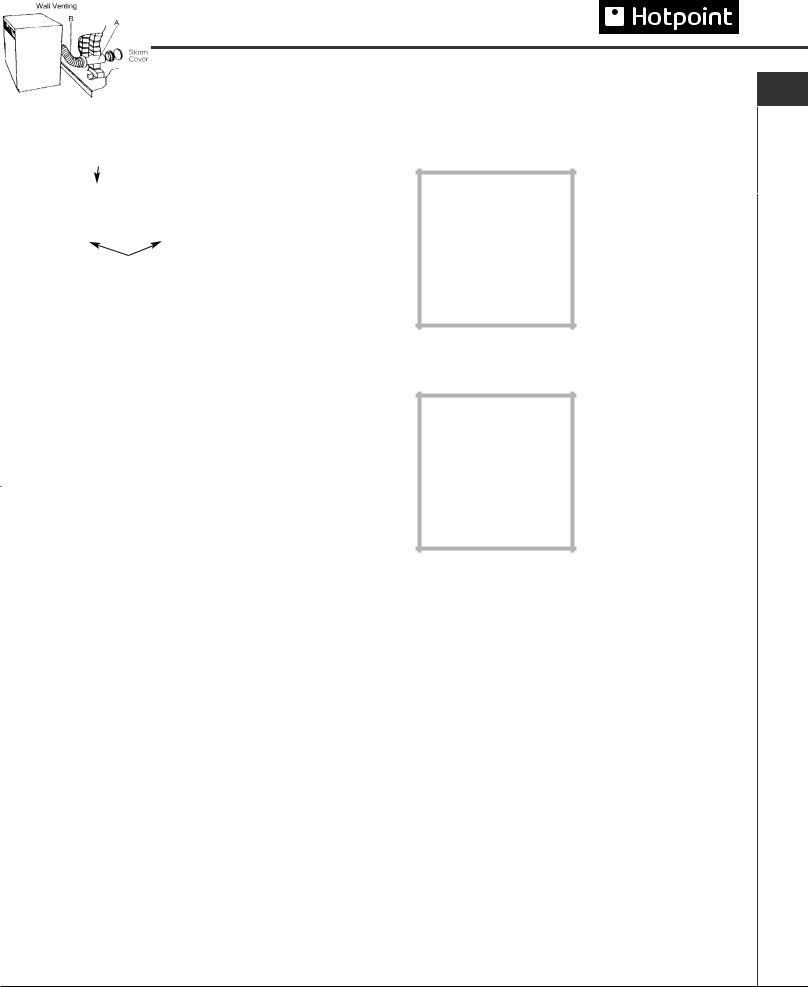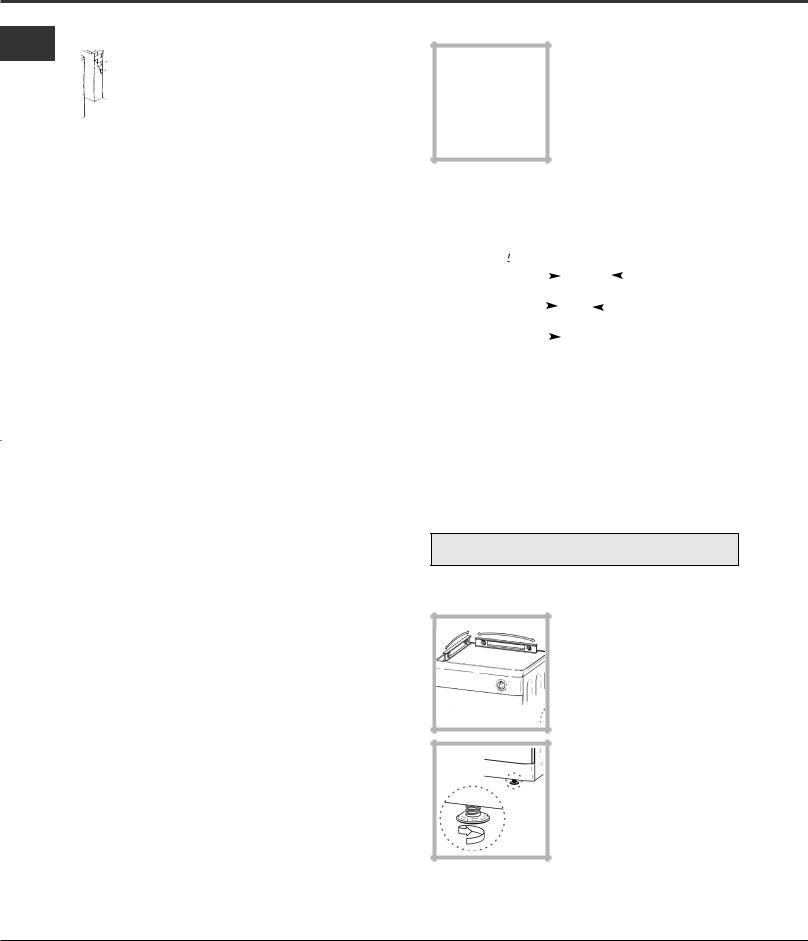Hotpoint TVEL 75 User Manual

Instruction booklet
TUMBLE DRYER
GB
English
TVEL 75 Experience
Contents
Important information, 2
Product data, 2
Installation, 3-4
Where to put your dryer
Ventilation
Electrical connection
Levelling your dryer
Before you start using your dryer
Dryer description, 5
The front
The back
Control panel
Start and programmes, 6-10
Choosing a programme Tables of Programmes The controls
Laundry, 11-12
Sorting your laundry
Wash care labels
Special clothing items
Drying times
Warnings and Suggestions, 13
General safety
Saving energy and respecting the environment
Maintenance and Care, 14
Switching off the electricity
Cleaning the filter after each cycle
Check the drum after each cycle
Cleaning the dryer
Troubleshooting, 15
Service, 16
Disposal
Hotpoint Guarantee, 19
Hotpoint After Sales Service, 20
!Keep this instruction booklet on hand in order to refer to it when necessary. Take it with you when you move, and should you sell this appliance or pass it on to another party, make sure that this booklet is supplied along with the dryer so that the new owner may be informed about warnings and suggestions on how the appliance works.
!Read these instructions carefully; the following pages contain important information on installation and suggestions on how the appliance works.
 This symbol reminds you to read this booklet.
This symbol reminds you to read this booklet.
GB
Information |
Important |
|
|
Installation |
|
|
|
Description |
|
|
|
Display The |
|
|
|
Programmes |
and Start |
|
|
Laundry |
|
|
|
Suggestions |
and Warnings |
|
|
Care and |
Maintenance |
|
|
Troubleshooting |
|
|
|
Service |
|
1

Important Information
For your Venting dryer to operate efficiently, you must follow the regular maintenance schedule shown below:
GB
Fluff Filter...
! You MUST clean the fluff filter after EVERY drying cycle.
STEP 1.
Open the door of your dryer.
STEP 4.
Refit the filter, with the curved side towards you.
STEP 2.
Pull out the filter (using the two finger grips).
STEP 5.
Make sure the filter is pushed fully home.
- NEVER run the dryer without the filter in position.
STEP 3.
Open the filter and clean any fluff deposits from the filter mesh.
! Failure to clean the filter after EVERY drying cycle will affect the drying performance of your machine.
-It will take longer to dry and as a result will use more electricity during drying.
!You MUST clean fluff build up around the filter housing and the vent tube periodically, EVERY two or three months:
-Check the vent tube and any permanent venting fixture to make sure that there has been no accumulation of fluff or lint, and remove it.
-Remove lint that collects around the filter and the outlet vents.
Product Data... (EU Regulation 392/2012)
Rated capacity of Cotton laundry for the standard programme at full load 7 kg |
Energy efficiency class B |
|
|
The weighted Annual Energy Consumption (AEc) 471.7 kWh
Consumption per year, based on 160 drying cycles of the standard cotton programme at full and partial load, and the consumption of the low-power modes. Actual energy consumption per cycle will depend on how the appliance is used.
This household tumble dryer is a Automatic Air-Vented Dryer
Energy consumption : full load Edry 4.04 kWh, partial load Edry1/2 2.12 kWh
Power consumption : off-mode (Po) 0.14 W, left-on mode (Pl) 1.96 W
Duration of the ‘left-on mode’ for power management systems 30 minutes
The ‘standard cotton programme’ suitable for drying normal wet cotton laundry that is the most efficient programme in terms of energy consumption for cotton used at full and partial load is Cottons - Cupboard Dry
Programme time (minutes) : weighted (Tt) full & partial load 84, full load (Tdry) 115, partial load (Tdry1/2) 60
Airborne acoustical noise emissions 69 dB(A) re 1 pW
This data is also available on the website http://www.hotpoint.eu/hotpoint/
2

Installation
Where to put your dryer
●Place your dryer at a distance from gas ranges, stoves, heaters, or cook tops because flames can damage the appliance.
Minimum gap 10mm |
● |
If you are going to install the |
|
||
|
|
appliance under a work |
|
|
|
|
|
counter, be sure to leave a |
|
|
10mm space between the |
|
|
top and any other objects on |
|
|
or above the machine and a |
Minimum gaps |
|
15mm space between the |
15mm |
|
sides and lateral furnishings |
|
|
or walls. This is to ensure |
|
|
proper air circulation. Make sure that the back vents are not obstructed.
●Make sure you put your dryer in an environment that is not damp and has proper air circulation throughout, the dryer will not operate efficiently in an enclosed space or cupboard.
! We do not recommend that the dryer is installed in a cupboard but the dryer must never be installed behind a lockable door, a sliding door or a door with a hinge on the opposite side to that of the dryer door.
Ventilation
The Dryer dries your laundry by drawing in cool, clean and relatively dry air, heating it, and then distributing it through the clothes as they are gently tumbled. For optimum performance, the moist air is then blown out through a vent tube at the back of the dryer.
When the dryer is in use, there has to be adequate ventilation to avoid the back flow of gases into the room from appliances burning other fuels, including open fires.
Mobile venting
A vent tube must always be fitted when the dryer is used in conjunction with Mobile Venting.
The tube must be fitted securely into the back of the dryer (see Dryer Description). If possible, it is always best to connect the tube to a permanent
outlet close to the dryer. If permanent installation is not possible, the dryer will work just as well with the tube passing through a partly-opened window.
!Ensure that the end of the tube is not directed toward the air intake vent at the rear of the dryer.
!The vent tube should not exceed 2.4 metres in length and should be kept free of any possible accumulation of fluff, lint and water by shaking it out frequently. Always ensure that the tube is not squashed.
Permanent venting
In conjunction with the vent tube we recommend using a Wall/Window Vent Kit, available at a retail location or the nearest Spare Parts Dealer.
Wall mounting
1. Leave an opening in the wall to the left of the dryers proposed position. 2. Keep the tube as short and straight as possible to prevent condensed moisture from backing up into the dryer.
3. Similarly, the duct in the wall should slope downwards towards the outside.
Window mounting
1. With a stacked dryer the hole in the window should ideally be made below the vent.
2. The tube should be kept as short as possible.
Depending on how often you use your dryer, it is essential that areas A and B are checked periodically to remove lint or debris.
The vent tube adaptor must be fitted securely thus preventing any humid air from being emitted back into the room.
!The Dryer should not be pushed so far back that the tube adaptor is pulled out of position or the tube is squashed or bent.
!The tube should be kept clear of the air intake vent and kinks or ‘U’ bends must be avoided as these will obstruct the tube or trap condensation.
GB
Information |
Important |
Installation |
|
|
|
Description |
|
|
|
Display The |
|
|
|
Programmes |
and Start |
|
|
Laundry |
|
|
|
Suggestions |
and Warnings |
|
|
Care and |
Maintenance |
|
|
Troubleshooting |
|
|
|
Service |
|
3

Installation
Open window venting
GB |
|
The end of the tube |
|
|
|
|
|
should be directed |
|
|
downwards, to prevent |
|
|
warm moist air from |
|
|
condensing in the room or |
|
|
in the dryer. |
|
|
|
!Ensure that the dryer is adequately ventilated and that the end of the vent tube is not directed towards the air intake duct.
!The vent tube must always be fitted for optimum performance.
!Make sure that the vent tube and air intake vents are not obstructed or blocked.
!The dryer must not recycle exhaust air.
!Misusing a tumble dryer may create a fire hazard.
!Do not discharge exhaust air into a flue which is used for exhaust fumes from other appliances that burn gas or other fuels.
!Do not discharge exhaust air into an extraction system or any duct with an extractor fan. This will affect the way the thermal controls operate and can result in a fire hazard.
Electrical connections
Make sure of the following before you insert the plug into the the electrical socket:
●The socket must be grounded.
●The socket must be able to sustain the machines maximum power, which is indicated on the rating label (see Dryer Description).
●Power voltage must be within the values indicated on the rating label (see Dryer Description).
●The socket must be compatible with the dryers plug. Should this not be the case, replace the plug or the socket.
!The dryer must not be installed outdoors, even if the space is sheltered. It can be very dangerous if it is exposed to rain or storms.
!Once installed, the dryers electrical wire and plug must be within easy reach.
!Do not use extension cords.
!The power cord must not be bent or squashed.
!The power cord supplied is fitted with a BS1363 plug and a 13 amp BS1362 fuse. If you need to replace the fuse, use only those rated at 13 amp (13A) and ASTA approved to BS1362.
Moulded plug
! The plug must not be used without the fuse cover in place. If a replacement fuse holder/cover is required, it must be of the same colour coding or wording as shown on the base of the plug. Replacements are available from authorised dealers.
Changing the plug
The wires in the power cord are coloured in accordance with the following:
Green and Yellow |
|
|
|
|
|
|
|
|
|
|
|||||
(Earth) wire to terminal |
|
|
|
|
|
|
|
|
|||||||
marked ‘E’, symbol |
|
|
|
|
, |
|
|
|
|
|
|
|
|
|
|
|
|
|
|
|
|
|
|
|
|
|
|||||
or coloured green and |
|
|
|
|
|
|
|
|
|
13A ASTA approved |
|||||
yellow. |
|
|
|
|
|
|
|
|
|
|
|||||
|
|
|
|
|
|
|
|
|
|
||||||
|
|
|
|
|
|
|
|
|
|
|
|
|
|
|
fuse to BS1362. |
Blue (Neutral) wire to |
|
|
|
|
|
|
|
|
|
|
|||||
terminal marked ‘N’ or |
|
|
|
|
|
|
|
|
Brown (Live) wire to |
||||||
coloured black. |
|
|
|
|
|
|
|
|
terminal marked ‘L’ or |
||||||
|
|
|
|
|
|
|
|
|
|
|
|
|
|
coloured red. |
|
|
Cord clamp |
|
|
|
|
|
|
|
|
|
|
||||
|
|
|
|
|
|
|
|
|
|
|
|||||
|
|
|
|
|
|
|
|
|
|
|
|
|
|
|
|
!If the plug being replaced is a non-rewirable type, then the cut-off plug must be disposed of safely. DO NOT leave it where it can be inserted into a socket and create a shock hazard.
!The power supply cord should be checked periodically and replaced by a cord specially prepared for this dryer and fitted only by authorised technicians (see Service). New or longer power cords are supplied at an extra charge by authorised dealers.
!The manufacturer denies any responsibility should any of these rules not be followed.
!If in doubt about any of the above consult a qualified electrician.
Levelling your dryer
The dryer must be installed level for correct operation. When you have installed your dryer in its final location check that it is level first side to side, then front to back.
If the dryer is not level, use a wooden block to
support it while adjusting the two front legs up or down, until your dryer is level.
Before you start using your dryer
Once you have installed your dryer and before you use it, clean the inside of the drum to remove any dust that could have accumulated during transport.
4

Dryer Description
The front |
|
|
The back |
|
|
|
|
|
|
|
|||
Control Panel |
|
Drum |
Air Intake Vent |
|||
|
||||||
|
|
|
Model & Serial numbers |
Rating plate |
||
|
|
|
||||
|
|
|
|
|
|
|
|
|
|
|
|
|
|
|
|
|
|
|
|
|
|
|
|
|
|
|
|
|
|
|
|
|
|
|
|
|
|
|
|
|
|
Filter |
Vent Tube fitted here |
Caution: Hot!
Control panel
PROGRAMMES |
START/PAUSE |
|
|
|
|
|
|||
Knob |
|
Clean Filter |
||
Button & Light |
|
|||
|
Indicator |
|
|
Light |
|
|
|
|
|
|
|
|
|
|
|
|
|
|
|
ON/OFF |
OPTION |
|
Progress or Delay |
Button |
Buttons & Lights |
|
Lights |
|
The ON/OFF button  : If the dryer is running and this button is pressed and held for more than 3 seconds, the dryer is turned off. Press and hold again for more than 3 seconds and the dryer reactivates.
: If the dryer is running and this button is pressed and held for more than 3 seconds, the dryer is turned off. Press and hold again for more than 3 seconds and the dryer reactivates.
The PROGRAMMES knob sets the programme: rotate it until the indicator is pointing to the programme you want to select (see Start and Programmes).
The OPTION buttons/lights select available options for your selected programme. The lights indicate that the option has been selected. If an option is not available the buzzer will beep three times (see Start and Programmes).
The START/PAUSE button/light  starts a selected programme. When you press this button there will be one beep and the progress lights will flash to confirm the action. When a programme is running, holding this
starts a selected programme. When you press this button there will be one beep and the progress lights will flash to confirm the action. When a programme is running, holding this
button in pauses the programme and stops the dryer. The light is green when programme is running, flashing amber if the programme has been paused or flashing green if on standby waiting to start a programme (see Start and Programmes).
Note: This light also flashes amber during the Post Care phase of a programme.
The Progress or Delay lights show you the status of the programme, or the delay time when they flash. During a delayed start the lights flash to show the delay selected. When (not flashing) they show each stage of the programme by the corresponding light turning on (see Start and Programmes).
The Clean Filter light gives you a reminder before every programme that it is essential to clean the filter every time the dryer is used (see Maintenance and Care).
GB
Information |
Important |
|
|
Installation |
|
Description |
|
|
|
Display The |
|
|
|
Programmes |
and Start |
|
|
Laundry |
|
|
|
Suggestions |
and Warnings |
|
|
Care and |
Maintenance |
|
|
Troubleshooting |
|
|
|
Service |
|
5

Start and Programmes
Choosing a programme
GB
1.Plug the dryer into the electrical socket.
2.Sort your laundry according to fabric type (see Laundry).
3.Open the door and make sure the filter is clean and in place (see Maintenance).
4.Load the machine and make sure items are not in the way of the door seal. Close the door.
5.If none of the lights are on: Press the ON/OFF button  .
.
6.Choose a programme by checking the Programmes Guide (see Programmes) as well as the indications for each type of fabric (see Laundry).
-Select a programme by rotating the PROGRAMMES knob.
7.Set a delay time and other options if necessary.
8.The START/PAUSE light is flashing green:
-press the START/PAUSE  button to begin. The green light stops flashing.
button to begin. The green light stops flashing.
During the drying programme, you can check on your laundry and take out items that are dry
Note:
while others continue drying. When you close the door again, press the START/PAUSE button in order to resume drying.
(When the door is opened the START/PAUSE light will flash Amber, after the door is closed and the START/PAUSE button pressed, the START/PAUSE light will stop flashing and show green.)
Note: During the Post Care phase this light flashes Amber.
9.At the end of the drying cycle the End light comes on and either :
-The buzzer will beep 3 times to let you know that your programme is complete. (Note: If the SOUND option was selected the buzzer beeps 3 times every 30 seconds for 5
minutes).
or - If you have selected the Crease Care option and you do not take the items out immediately, the items will tumble occasionally for 10 hours or until you open the door, the buzzer will then beep 3 times to confirm the programme is completed.
10.Open the door, take the laundry out, clean the filter and replace it (see Maintenance).
11.Unplug the dryer.
This tumble dryer, in compliance with new energy saving regulations, is fitted with an automatic standby system which is enabled after about 30 minutes if no activity is detected. Press the ON/OFF button briefly and wait for the dryer to reactivate.
 Shirts Light Dry
Shirts Light Dry
High heat option
●This is a programme for shirts made from cotton.
●It can be used for load sizes up to 3kg (approximately 10 shirts).
●This programme will take about 60 minutes, but may take longer depending on the size of the load and the spin speed used in your washer.
Low heat option
●This is a programme for shirts made from synthetic materials or a mixture of natural and synthetic materials, such as polyester and cotton.
●It can be used for load sizes up to 3kg (approximately 14 shirts).
●This programme will take about 55 minutes, but may take longer depending on the size of the load and the spin speed used in your washer.
Shirts dried using this programme are usually ready to put away, the edges or seams may be slightly damp. If this is the case, try turning the shirts inside out and running the programme again for a short period.
 Jeans
Jeans
●This is a programme for jeans made from denim cotton. Before drying your jeans turn the front pockets inside out.
●It can be used for load sizes up to 3kg (approximately 4 pairs).
●Do not mix dark and light coloured items.
●It can also be used on other garments made from the same material, such as jackets.
●This programme will take about 85 minutes, but may take longer depending on the size of the load and the spin speed used in your washer.
●Loads dried using this programme are usually ready to wear, the edges or seams may be slightly damp. If this is the case, try turning the jeans inside out and running the programme again for a short period.
! We do not recommend that you use this programme if your jeans have elastic waist bands, studs or embroidery.
6
